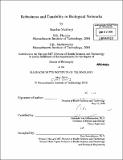Robustness and tunability in biological networks/ by Shankar Mukherji.
Author(s)
Mukherji, Shankar, 1982-
DownloadFull printable version (19.72Mb)
Alternative title
Robustness and tunability in biological systems
Other Contributors
Harvard University--MIT Division of Health Sciences and Technology.
Advisor
Alexander van Oudenaarden.
Terms of use
Metadata
Show full item recordAbstract
Cells face a core tension between studiously preventing change in certain properties from extrinsic perturbations while allowing other properties to be tuned. One way cells have resolved this tension is to utilize systems that are both robust and tunable. Systems can achieve this through network design, which can contain submodules that are themselves either robust or tunable, or through network components that are robust over only a defined set of parameter ranges. This work examines these two categories with two specific examples described below. To explore how a simple network can be both robust and tunable, we make use of the osmosensing pathway in the budding yeast Saccharomyces cerevisiae. The pathway consists of two modules: a phosphorelay module that senses the osmotic shock signal that feeds into a mitogen-activated protein kinase (MAPK) module. Using a combination of systematic complementation experiments and computational sensitivity analysis, we show that the phosphorelay module is robust to changes in the kinetic parameters characterizing signal propagation through the module while signaling through the MAPK module can be tuned by changing the rate constants. Furthermore, we show that pathway robustness to rate constant changes has consequences for the evolvability of the osmosensing cascade. Populations of yeast cells challenged to alter the input/output relationship of the cascade saw their MAPK proteins preferentially targeted by natural selection over their phosphorelay counterparts. To explore how a simple regulatory element can be both robust and tunable, we turn our attention to gene regulation by microRNA (miRNA). MiRNAs are short regulatory RNA molecules that repress gene expression in a sequence-dependent manner. By observing the strength of miRNA-mediated repression in individual cells, we show that the strength of repression depends strongly on the relative abundance of the miRNA and its target. Below a threshold level of target message miRNA robustly silences the conversion of mRNA input into protein output, but above this threshold miRNAmediated repression generates an ultrasensitive response to mRNA input allowing the strength of repression to be tuned over a wide variety of values.
Description
Thesis (Ph. D.)--Harvard-MIT Division of Health Sciences and Technology, 2010. Cataloged from PDF version of thesis. Includes bibliographical references (p. 123-139).
Date issued
2010Department
Harvard University--MIT Division of Health Sciences and TechnologyPublisher
Massachusetts Institute of Technology
Keywords
Harvard University--MIT Division of Health Sciences and Technology.